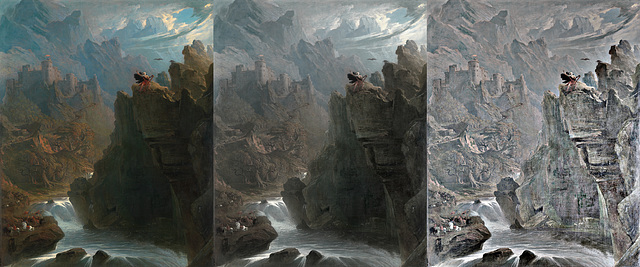John Martin' s "The Bard" prepared for analysis


Source of the painting on the left side:
deliver.odai.yale.edu/content/id/594cf828-e6b8-4ec4-bf14-cac45880305d/format/3
left: John Martin, The Bard
center: desaturated, increased contrast of large dark area (rocks) on the right side
right: GIMP, Retinex filtering: Scale=160, ScaleDivision=6, Dynamic=2.5
=====================
John Martin: The Bard
ca. 1817
Yale Center for British Art, Paul Mellon Collection
collections.britishart.yale.edu/vufind/Record/1671616:
"Based on a Thomas Gray poem, inspired by a Welsh tradition that said that Edward I had put to death any bards he found, to extinguish Welsh culture; the poem depicts the escape of a single bard.
In mydailyartdisplay.wordpress.com/the-bard-by-john-martin, "Jonathan" connects the painting to the poem The Bard written by by Thomas Gray in 1755:
· · ...
· · On a rock, whose haughty brow
· · Frowns o'er cold Conway's foaming flood,
· · Robed in the sable garb of woe
· · With haggard eyes the Poet stood;
· · ...
· · "Enough for me: with joy I see
· · The diff'rent doom our fates assign.
· · Be thine Despair and sceptred Care;
· · To triumph and to die are mine."
· · He spoke, and headlong from the mountain's height
· · Deep in the roaring tide he plunged to endless night.
· · ...
The poem and the painting may have been an inspiration to Lewis Carroll and Henry Holiday in The Hunting of the Snark:
· · 545· · Erect and sublime, for one moment of time.
· · 546· · · · In the next, that wild figure they saw
· · 547· · (As if stung by a spasm) plunge into a chasm,
· · 548· · · · While they waited and listened in awe.

Album:

John Martin
deliver.odai.yale.edu/content/id/594cf828-e6b8-4ec4-bf14-cac45880305d/format/3
left: John Martin, The Bard
center: desaturated, increased contrast of large dark area (rocks) on the right side
right: GIMP, Retinex filtering: Scale=160, ScaleDivision=6, Dynamic=2.5
=====================
John Martin: The Bard
ca. 1817
Yale Center for British Art, Paul Mellon Collection
collections.britishart.yale.edu/vufind/Record/1671616:
"Based on a Thomas Gray poem, inspired by a Welsh tradition that said that Edward I had put to death any bards he found, to extinguish Welsh culture; the poem depicts the escape of a single bard.
In mydailyartdisplay.wordpress.com/the-bard-by-john-martin, "Jonathan" connects the painting to the poem The Bard written by by Thomas Gray in 1755:
· · ...
· · On a rock, whose haughty brow
· · Frowns o'er cold Conway's foaming flood,
· · Robed in the sable garb of woe
· · With haggard eyes the Poet stood;
· · ...
· · "Enough for me: with joy I see
· · The diff'rent doom our fates assign.
· · Be thine Despair and sceptred Care;
· · To triumph and to die are mine."
· · He spoke, and headlong from the mountain's height
· · Deep in the roaring tide he plunged to endless night.
· · ...
The poem and the painting may have been an inspiration to Lewis Carroll and Henry Holiday in The Hunting of the Snark:
· · 545· · Erect and sublime, for one moment of time.
· · 546· · · · In the next, that wild figure they saw
· · 547· · (As if stung by a spasm) plunge into a chasm,
· · 548· · · · While they waited and listened in awe.

Album:

John Martin
- Keyboard shortcuts:
Jump to top
RSS feed- Latest comments - Subscribe to the comment feeds of this photo
- ipernity © 2007-2024
- Help & Contact
|
Club news
|
About ipernity
|
History |
ipernity Club & Prices |
Guide of good conduct
Donate | Group guidelines | Privacy policy | Terms of use | Statutes | In memoria -
Facebook
Twitter

"I will not refrain from setting among these precepts a new device for consideration which, although it may appear trivial and almost ludicrous, is nevertheless of great utility in arousing the mind to various inventions. And this is, that if you look at any walls spotted with various stains, or with a mixture of different kinds of stones, if you are about to invent some scene you will be able to see in it a resemblance to various different landscapes adorned with mountains, rivers, rocks, trees, plains, wide valleys, and various groups of hills. You will also be able to see divers combats and figures in quick movement, and strange expression of faces, and outlandish costumes, and an infinite number of things which you can then reduce into separate and well-conceived forms. With such walls and blends of different stones it comes about as it does with the sound of bells, in whose clanging you may discover every name and word you can imagine."
Source: en.wikipedia.org/w/index.php?title=Pareidolia&oldid=610862866#Art (2014-05-13) and nevalalee.wordpress.com/2013/08/03/leonardos-ink-blots (2014-06-07)
See also "OF DEVICES FOR PAINTERS 173" (MS. 2038, Bib. Nat. 22 v.) in www.archive.org/stream/leonardodavincis007918mbp/leonardodavincis007918mbp_djvu.txt
Sign-in to write a comment.